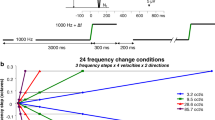Summary
In the present paper the input-output functions of the slow acoustically evoked potential are determined under the following conditions: vertex-, ipsi-lateral and contra-lateral pick-up. In all three modes of pick-up we got the input-output function of the high stimulus repetition rate;—this means: for the adapted stage of the system as well as that for the small repetition rate, the non-adapted stage. In all three modes of pick-up we found a different input-output-function and a difference between the adapted and the non-adapted stage. The simultaneous registration is more advisable than the successive one. We determined the normal characteristic curves of 10 adults in order to compare them with patients. The vertex-pick-up seems to be the best one for determining the threshold, whereas the contralateral pick-up seems to give more information about the pathological function of the acoustic system.
Zusammenfassung
Die vorliegende Arbeit stellt für den klinischen Gebrauch verwertbare Kennlinien des langsamen akustisch evozierten Potentials auf, und zwar für die folgenden 3 Ableitungsorte: am Vertex, an der ipsilateralen und an der kontralateralen Schläfe. Für diese 3 Ableitungsorte wurde die Kennlinie sowohl bei hoher als auch bei niedriger Reizfolgefrequenz untersucht. An allen 3 Stellen ergaben sich dabei voneinander unterschiedliche Kennlinien; an jedem Ableitort unterscheidet sich die adaptierte Kennlinie (d. h. bei hoher Reizfolgefrequenz) von der nicht-adaptierten (geringe Reizfolgefrequenz), ist aber signifikant größer und erscheint schon bei geringerer Reizintensität bei kontralateraler Ableitung. Die Ergebnisse bei simultaner (alle 3 Ableitungsorte gleichzeitig) und successiver (alle 3 Ableitorte hintereinander) werden verglichen. Anhand der Kennlinien von 10 normalhörenden Versuchspersonen werden die zweier Patienten mit Innenohrstörungen gewertet. Die 3-kanalige, simultane Ableitung ergibt mehr Sicherheit und eine erweiterte Information.
Similar content being viewed by others
References
Keidel, W. D.: Neuere Ergebnisse der Physiologie des Hörens. Arch. klin. exp. Ohr.-, Nas.- u. Kehlk.-Heilk. 185, 548–575 (1965).
— Spreng, G.: Neurophysiological evidence for the stevens power function in man. J. acoust. Soc. Amer. 38, 191–195 (1965).
Lindner, A.: Statistische Methoden, S. 153–213. Basel: Birkhäuser 1964.
Rapin, J., Grazian, L. J.: Auditory-evoked responses in normal, brain-damaged, and deaf infants. Neurology (Minneap.) 17, 881–894 (1967).
Stange, G., Soda, T.: Quantitative Untersuchungen zur Hörschwelle, Adaptation und Lautheitsempfindung am gesunden und hörgeschädigten Menschen mittels der „Objektiven Audiometrie”. Arch. klin. exp. Ohr-, Nas.- u. Kehlk.-Heilk. 190, 210–228 (1968).
Author information
Authors and Affiliations
Additional information
Supported by the Fonds zur Förderung der wissenschaftlichen Forschung (CAT-Computer “Volkwagen”-Foundation).
Rights and permissions
About this article
Cite this article
Müller, G., Stange, G. The input-output function of the slow auditory evoked potential in contralateral, ipsilateral, and vertex recordings. Arch. Klin. Exp. Ohr.-, Nas.- U. Kehlk. Heilk. 198, 116–126 (1971). https://doi.org/10.1007/BF00419528
Issue Date:
DOI: https://doi.org/10.1007/BF00419528



